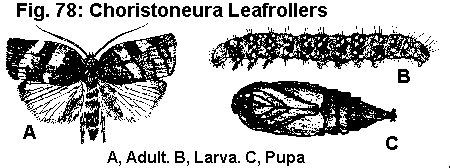Obliquebanded leafroller, Choristoneura rosaceana (Harris),
spotted fireworm, Choristoneura parallela (Robinson), Tortricidae, LEPIDOPTERA
 Spotted fireworm: A, Adult. B, Larva.
C, Pupa.
Spotted fireworm: A, Adult. B, Larva.
C, Pupa. Choristoneura Leafroller
Return to: MREC Home Page Return to: Key to Caterpillars
DESCRIPTION
Adult- The adult obliquebanded leafroller is a 1.7 to 3.3 cm, dark deep yellow to reddish-brown moth with pale orange-yellow (males) to deep yellow (females) hind wings. Female moths are larger than males. The spotted fireworm moth is a smallish (1.9 to 2.5 cm) light reddish to orange-brown moth with two dark patches on the outer margins of the top wings.
Eggs- No description found.
Larvae- The spotted fireworm has two small brown spots on the front margin of the thoracic shield and the anal shield has some brownish pigments. The obliquebanded leafroller does not have spots on the throracic shield or brownish pigment on the anal shield (the length of both species ranges up to 19 mm).
Pupae- No description found.
Fig. 78: Choristoneura Leafrollers
Obliquebanded leafroller, Choristoneura rosaceana
(Harris),
spotted fireworm, Choristoneura parallela (Robinson),
Tortricidae, LEPIDOPTERA  Spotted fireworm: A, Adult. B, Larva.
C, Pupa.
Spotted fireworm: A, Adult. B, Larva.
C, Pupa.
Distribution- The obliquebanded leafroller is found throughout most of the United States except the arid Southwest. The spotted fireworm occurs from Ontario and Maine to Florida and west to Missouri and Mississippi.
Host Plants- The obliquebanded leafroller feeds on many kinds of plants including poinsettia. It overwinters on the stems of rosaceous trees and other hardwoods. Spotted fireworms have been collected from blueberries, citrus, cranberry, almond, gardenia, goldenrod, roses, sheep laurel, and azalea leaves.
Damage- The obliquebanded leafroller ties leaves together and feeds in that shelter. The caterpillars often tie the new leaves of poinsettia together so firmly that as the leaves develop, they are constricted and distorted by the silk.
Life History- There are two broods of obliquebanded leafrollers in North Carolina although there may be three generations per year in Tennessee. Moths have been collected from late April through October. The obliquebanded leafroller enters diapause in autumn when shorter days and lower temperatures make conditions unsuitable for growth and development. The obliquebanded leafroller overwinters as second to fourth stage larvae in tiny, tight cocoons called hibernacula. The overwintering caterpillars emerge and begin feeding on the new growth in spring. The caterpillars pupate and within a few weeks a new generation of moths emerges to mate and lay eggs. Males emerge before females. Therefore it is best to wait a few days after adults are first noticed before applying some sort of control measures. Females lay their eggs in small masses of about 200 on the leaves of various trees, shrubs and flowers. Newly hatched caterpillars disperse vigorously and even can be blown about from plant to plant. The caterpillars develop through seven instars. It has been shown that obliquebanded leafroller caterpillars develop more rapidly on tender new leaves than on mature leaves
CONTROL
The obliquebanded leafroller has several parasites including Meterous trachynotus Viereck and Macrocentrus iridescens (Fr.). The microsporidian Nosema fumiferanae (Thomson) causes high mortality in young larvae. However, if older larvae become infected, some pupate successfully and (infected) adults may emerge. Frass from infected caterpillars may infect other larvae. For specific chemical control recommendations, consult the current Cooperative Extension Service publications on ornamental plant pest management.
University of Florida/IFAS Reference to Pest Control Guides